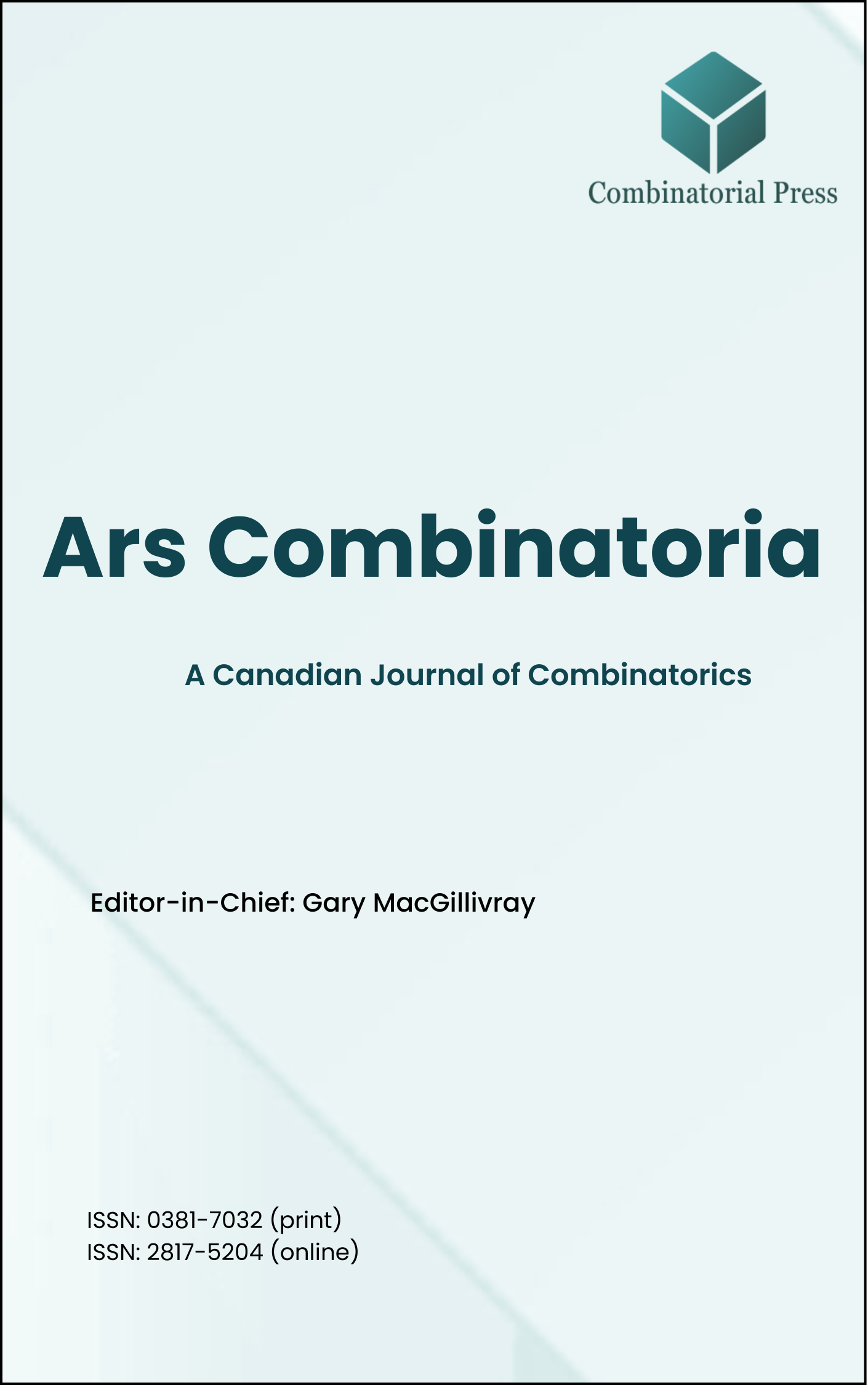
Ars Combinatoria
ISSN 0381-7032 (print), 2817-5204 (online)
Ars Combinatoria is the oldest Canadian Journal of Combinatorics, established in 1976. The journal is dedicated to advancing the field of combinatorial mathematics through the publication of high-quality research papers. From 2024 onward, it publishes four volumes per year in March, June, September and December. Ars Combinatoria has gained recognition and visibility in the academic community and is indexed in renowned databases such as MathSciNet, Zentralblatt, and Scopus. The Scope of the journal includes Graph theory, Design theory, Extremal combinatorics, Enumeration, Algebraic combinatorics, Combinatorial optimization, Ramsey theory, Automorphism groups, Coding theory, Finite geometries, Chemical graph theory but not limited.
Information Menu
- Research article
- Full Text
- Ars Combinatoria
- Volume 029
- Pages: 107-116
- Published: 30/06/1990
The Pfaffian of the symbols \(a_{ij}\) with \(i<j\) has a combinatorial interpretation as the signed weight generating function of perfect matchings in the complete graph. By properly specializing the variables, this generating function reduces to the signed weight generating function for the perfect matchings in an arbitrary simple graph. We construct a weight and sign preserving bijection between two appropriately constructed spaces of permutations: permutations with even cycles and pairs of involutions without fixed points. This bijection gives a purely combinatorial proof that the determinant of a zero axial skew-symmetric matrix is equal to the square of the Pfaffian.
- Research article
- Full Text
- Ars Combinatoria
- Volume 029
- Pages: 97-105
- Published: 30/06/1990
We construct nilpotent \(SQS\)-skeins of class \(n\), for any positive integer \(n\). These \(SQS\)-skeins are all subdirectly irreducible algebras. The nilpotent \(SQS\)-skeins of class \(n\), which are constructed in this paper, are also solvable of order \( \leq \frac{n+1}{2} \) if \(n\) is odd, and of order \(\leq 1+\frac{1}{2}n\) if \(n\) is even.
- Research article
- Full Text
- Ars Combinatoria
- Volume 029
- Pages: 87-95
- Published: 30/06/1990
We employ a well-known class of designs to give a complete solution to the problem of determining the spectrum of uniform semiframes with block size two. As a corollary we prove that the complete graph \(K_{gu}\), admits a one-factorization with an orthogonal set of \(u\) disjoint sub-one-factorizations of \(K_g\) if and only if \(g\) is even and \(u\geq3\).
- Research article
- Full Text
- Ars Combinatoria
- Volume 029
- Pages: 73-86
- Published: 30/06/1990
This paper concerns the existence of graphs and digraphs with prescribed mean distance and the existence of graphs with prescribed mean local connectivity.
- Research article
- Full Text
- Ars Combinatoria
- Volume 029
- Pages: 65-72
- Published: 30/06/1990
Let \(v\), \(k\), and \(\lambda\) be positive integers. A \((v, k, \lambda)\)-Mendelsohn design (briefly \((v,k,\lambda)\)-MD) is a pair \((X,B)\) where \(X\) is a \(v\)-set (of points) and \(B\) is a collection of cyclically ordered \(k\)-subsets of \(X\) (called blocks) such that every ordered pair of points of \(X\) are consecutive in exactly \(\lambda\) blocks of \(B\). A set of $\delta$ distinct elements \(\{a_1,a_2,…,a_\delta\}\) is said to be cyclically ordered by \(a_1<a_2<…<a_k<a_1\) and the pair \(a_i,a_{i+t}\) are said to be \(t\)-apart in a cyclic \(k\)-tuple \((a_1,a_2,…,a_k)\) where \(i+ t\) is taken modulo \(k\). If for all \(t=1,2,…, k-1\), every ordered pair of points of \(X\) are \(t\)-apart in exactly \(\lambda\) blocks of \(B\), then the \((v,k,\lambda)\)-MD is called a perfect design and is denoted briefly by \((v,k,\lambda)\)-PMD. A necessary condition for the existence of a \((v,k,\lambda)\)-PMD is \(\lambda v(v-1)\equiv0\) (mod \(k\)). In this paper, we shall be concerned mainly with the case where \(k=4\). It will be shown that the necessary condition for the existence of a \((v,4,\lambda)\)-PMD, namely, \(\lambda v(v-1)\equiv0\) (mod \(4\)), is also sufficient, except for \(v=4\) and \(\lambda\) odd, \(v=8\) and \(\lambda=1\), and possibly excepting \(v=12\) and \(\lambda=1\). Apart from the existence of a \((12,4,1)\)-PMD, which remains very much in doubt, the problem of existence of \((v,4,\lambda)\)-PMDs is now completely settled.
- Research article
- Full Text
- Ars Combinatoria
- Volume 029
- Pages: 53-63
- Published: 30/06/1990
Let \(S\) and \(T\) be subsets of a finite group \(G with identity \(e\), We write \(G-e =ST\) if every non-identity element \(g\) can be written uniquely as \(g = st\) with \(s \in S\) and \(t \in T\). These near-factorizations are motivated by the combinatorial problem of
finding \((0 , 1)\)-matrix factorizations of the matrix \(J-I\). We derive some results on near-factors \(S\) and \(T\). For example, \(S\) and \(T\) each generate \(G\). Also, if \(G\) is abelian, then the automorphism \(g \rightarrow g^{-1}\) is a multiplier of both \(S\) and \(T\). If the elementary abelian group \(C_p^n\) (\(p\) an odd prime) is a homomorphic image of \(G\), then \(|S|^{p-1} \equiv |T|^{p-1} \equiv 1
(mod p)\). These structure theorems suggest that noncyclic abelian groups rarely have near-factorizations. Constructions of near-factorizations are given for cyclic groups and dihedral groups.
- Research article
- Full Text
- Ars Combinatoria
- Volume 029
- Pages: 43-52
- Published: 30/06/1990
We prove that the intersection of longest paths in a connected graph \(G\) is nonempty if and only if for every block \(B\) of \(G\) the longest paths in \(G\) which use at least one edge of \(B\) have nonempty intersection. This result is used to show that if every block of a graph \(G\) is Hamilton-connected, almost-Hamilton-connected, or a cycle then all longest paths in \(G\) intersect. (We call a bipartite graph almost-Hamilton-connected if every pair of vertices is connected by a path containing an entire bipartition set.) We also show that in a split graph all longest paths intersect. (A graph is split if there exists a partition of its vertex set into a stable set and a complete set.)
- Research article
- Full Text
- Ars Combinatoria
- Volume 029
- Pages: 33-41
- Published: 30/06/1990
Blocking sets in little and large Mathieu designs, have all been characterized except the case \(S(5, 8, 24)\). The aim of this paper is to give the complete classification of blocking sets in this remaining case.
- Research article
- Full Text
- Ars Combinatoria
- Volume 029
- Pages: 28-32
- Published: 30/06/1990
For a graph \(G\), define \(\phi(G) = \min \{\max \{d(u), d(v)\} | d(u,v) = 2\}\) if \(G\) contains two vertices at distance 2, and \(\phi(G) = \infty\) otherwise. Fan proved that every 2-connected graph on \(n\) vertices with \(\phi(G) > \frac{1}{2}n\) is hamiltonian. Short proofs of this result and a number of analogues, some known, some new, are presented. Also, it is shown that if \(G\) is 2-connected, \(\phi(G) \geq \frac{1}{2}(n-i)\) and \(G – \{v \in V(G) | d(v) \geq \frac{1}{2} (n-i)\}\) has at least three components with more than \(i\) vertices, then \(G\) is hamiltonian (\(i \geq1\)).
- Research article
- Full Text
- Ars Combinatoria
- Volume 029
- Pages: 24-27
- Published: 30/06/1990
We state here that, for modulus \(m\) odd and less than \(2^{29}+2^{27} – 1\), no (nontrivial) perfect binary arithmetic code, correcting two errors or more, exists (this is to be taken with respect to the Garcia-Rao modular distance). In particular, in the case \(m = 2^n \pm 1\), which is most frequently studied, no such code exists for \(m < 2^{33} – 1\).





